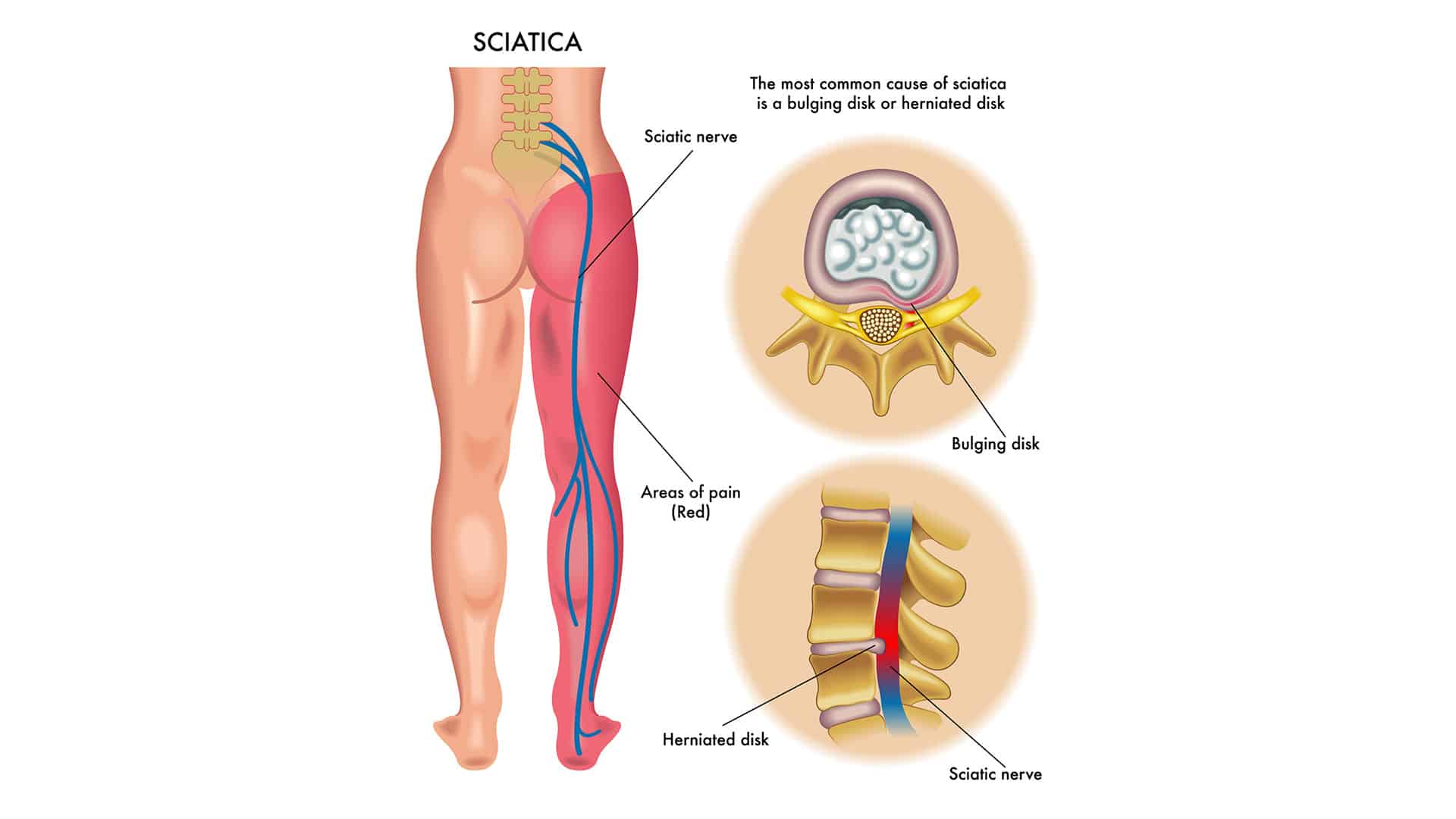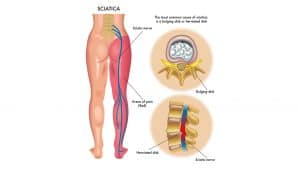Sciatica is one of the most misunderstood problems that you can get.
It’s a very common condition to diagnose yourself with, but in fact it’s not a condition at all but rather a symptom; which means…
There is always an underlying cause that is bringing on your sciatica symptoms.
There are a number of sciatica causes that start the symptoms you experience, most of which originate in the lower back.
What Causes Sciatica To Begin?
Sciatica is a term which comes from compression or irritation to your sciatic nerve, which begins in the lower back and runs down the back of the leg to the knee.
From here it splits into two separate nerve that continue down the calf and into your foot.
The sciatic nerve when irritated, compressed or impinged is what causes sciatica to start and can lead to significant discomfort in the form of pins and needles, tingling, weakness or a sharp burning sensation down your leg.
The most common sciatica causes that lead to the symptoms you are experiencing come from:
– Bulging/slipped disc
– Spinal degeneration (also known as spinal canal stenosis)
– Piriformis syndrome
– Spondylolisthesis
Bulging/Herniated Disc
A bulging/slipped disc also known as a disc protrusion can cause you to experience the symptoms of sciatica.
The disk is a substance between each bone in your spine and acts as a shock absorber to reduce force being transmitted down the back.
Certain movements especially bending forward and twisting, as well as picking up heavy objects can cause the disk to protrude or ‘slip’.
When the disc bulges in the lower back the material that makes up the disk impinges on the nerve either to the left or the right side of the spine. Depending on the specific nerve which is being irritated by the disc can give you sciatic pain running down the left or right leg.
Spinal Canal Stenosis
This is one of the most common sciatica causes in older people where you may experience pain running down the leg.
Spinal canal stenosis usually begins occurring as you age due to degeneration and arthritic changes to the bones in the spine.
In the spinal column is an oval shaped hole known as the foramen where the spinal nerve roots run through. Particular parts of the bone begin to degenerate due to:
– Arthritis
– Poor Posture
– Wear and tear because of aging
As this degeneration continues the space in the foramen decreases leading to impingement on the nerve. This impingement or irritation on the nerve root which supplies the sciatic nerve leads to the pain you feel described as ‘sciatica’.
Piriformis Syndrome
Piriformis syndrome is one of the causes of sciatica that is quite under-looked yet is a very common reason why you may get sciatica.
A few simple tests by a health practitioner like a chiropractor can give you an accurate diagnosis of whether you suffer from piriformis syndrome, leading to your sciatica symptoms.
The piriformis is a muscle on the left and right side of your buttock and runs from the dimple in your lower back (Posterior Superior Iliac Joint) to the bony part known as the greater trochanter on the outside of your hip.
The sciatic nerve runs directly underneath the piriformis but in about 15-17% of people the sciatic nerve pierces the piriformis and runs between the muscle. When the muscle contracts or gets tight it can irritate the sciatic nerve causing tingling, pain or pins and needles to run down the leg.
There are a number of reasons why the piriformis can get tight the most common being:
– Bad posture
– Prolonged sitting
– Lower back pain leading to changes in the hip
– Biomechanical changes like flat feet, pelvic tilt or short leg
Spondylolisthesis
Moving on from its rather odd name, spondylolisthesis is the least common cause of sciatica. The name refers to a bone in the lower back slipping forward in relation to the one below it.
This occurs due to a small fracture in the bone that holds the spine in place and comes about because of constant stress to the bone. The fracture usually occurs in childhood and in most cases will never show any symptoms.
While this is true for most people, 15-20% of people who have a spondylolisthesis will show symptoms in adulthood.
This occurs due to irritation of the sciatic nerve because of this forward slippage of the bone.
Specific treatment is given to reduce the symptoms of this condition so it is vital for you to talk to a health practitioner to first of all have it correctly diagnosed and secondly to get the correct treatment for it.
Accurate Diagnosis Helps Relieve The Causes Of Sciatica
If you’re suffering from sciatica, finding out the underlying cause of the problem is very important in how you can go about treating it.
A Sydney chiropractor, physiotherapist or medical practitioner can all diagnose your symptoms and perform the correct examinations to diagnose your problem.
Diagnosing the underlying cause of your sciatica can speed up your recovery and keep your pain away because a specific treatment program can be prescribed based on the origin of your symptoms.
Sciatica symptoms can be very troublesome to deal with. If you feel as though sciatica treatment can help relieve your pain call today or book online to see if we can help you.





